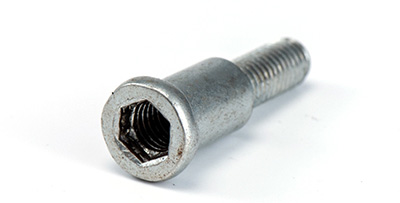Mold manufacturing is an important part of modern industrial production, involving high-precision, high-durability components that ensure product consistency and quality. In this process, the selection of Fasteners is critical to the functionality and longevity of the mold. Among them, Hex Socket Head Shoulder Screws are key components in mold manufacturing due to their unique design and superior performance.

Structure and Features of Hex Socket Head Shoulder Screws
Hex Socket Head Shoulder Screws have a unique shoulder design that distinguishes them from conventional fasteners. The shoulder of a screw is usually an unthreaded cylindrical portion that is larger in diameter than the threaded portion. The shoulder design allows the screws to provide not only tightening, but also precise spacing and alignment in the application. In addition, the screw's hexagonal head design facilitates installation using an Allen wrench, which can provide greater torque in narrow or deep holes to ensure fastening reliability.
Application Scenarios in Mold Making
In mold manufacturing, Hex Socket Head Shoulder Screws are often used to fasten and position mold parts that require high precision. The following are some typical application scenarios:
1. Guiding and positioning:Shoulder Screws are often used for guiding and positioning between the moving and fixed molds of a mold to ensure that the mold remains accurately aligned during repeated opening and closing of the mold. This application requires that the shoulder of the screw be highly consistent in size to provide consistent gap control in the mold.
2. Holding removable parts:Molds often need to hold removable parts such as slides, ejector plates, etc. The shoulders of Hex Socket Head Shoulder Screws hold these parts precisely in place while allowing them to be flexibly disassembled and assembled when needed, facilitating mold maintenance and adjustment.
3. Support for Sliding Parts:In some mold designs, sliding parts need to maintain a certain degree of freedom during operation. The smooth cylindrical shoulders of the shoulder screws can provide smooth sliding surfaces for these parts, reducing friction and wear and extending the life of the mold.
Material and Finish Selection
Hex Socket Head Shoulder Screws are often made from high strength materials such as high carbon steel, stainless steel and alloy steel in mold manufacturing. These materials provide excellent strength and durability and can withstand the working load of the mold in a high-pressure, high-temperature environment. In addition, the surface of the screw is usually treated with special treatment, such as nickel-plated, chrome-plated or oxidized to enhance its corrosion resistance and surface hardness, thus further extending the service life of the mold.
Precision Requirements and Quality Control
In mold manufacturing, the precision requirements for Hex Socket Head Shoulder Screws are very high, especially the diameter and length of the shoulder must be strictly controlled to ensure that the screws can provide stable support and positioning function in the mold. Typically, these screws need to comply with international standards, such as ISO 7379 or DIN 923, to ensure that their dimensions and performance meet industrial requirements.
In terms of quality control, manufacturers usually conduct stringent dimensional checks, hardness tests and surface quality inspections on each batch of screws to ensure that the screws are able to perform optimally in the mold making process. These tests not only ensure the accuracy and consistency of the screws, but also improve the overall manufacturing quality of the mold and reduce downtime and maintenance costs due to screw failure.
Advantages in Mold Design
A significant advantage of using Hex Socket Head Shoulder Screws for mold making is their versatility. The shoulder design of the screw allows it to perform both fastening and positioning functions, reducing the need for additional components in mold design and simplifying the mold structure. In addition, the hexagonal head design makes the screws easy to install, even in areas where space is limited.
Since these screws allow precise control of the position and clearance of mold components, they help improve the efficiency and accuracy of the mold, reducing product defect rates and scrap. In addition, these screws are also very convenient during mold disassembly and maintenance, reducing downtime and improving the overall efficiency of the production line.
The use of Hex Socket Head Shoulder Screws in mold manufacturing offers significant advantages in mold design and production. Their unique shoulder structure and hexagonal head design enable them to provide not only stable fastening but also precise positioning and support functions in molds. By choosing the right material and surface treatment, and ensuring the accuracy and quality of the screws, mold makers can significantly improve the service life and productivity of their molds, providing more reliable and efficient mold solutions for modern industrial production.





